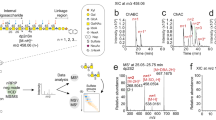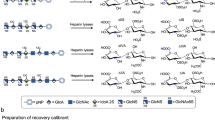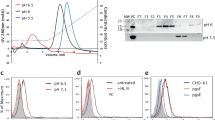Abstract
CHONDROITIN sulphates, which are regarded as polymers composed of approximately equimolar quantities of N-acetylgalactosamine, hexuronic acid and sulphate, have been classified as chondroitin-4-sulphate (chondroitin sulphate A and B) and chondroitin-6-sulphate (chondroitin sulphate C)1. In infra-red spectroscopic studies, evidence has been presented that chondroitin sulphates showed characteristic absorption bands at the 700–1,000 cm.−1 region, which may differentiate chondroitin-4-sulphate and the 6-sulphate2–4. A recent communication5 indicated that the infra-red spectra of acetylgalactosamine-4-sulphate obtained from chondroitin sulphate A and B, and of acetylgalactos-amine-6-sulphate from chondroitin sulphate of shark cartilage, corresponded respectively to those of chondroitin-4-sulphate and the 6-sulphate. Accordingly, the spectral differences would be attributed to the presence of the C4 and C6 sulphate in the galactosamine moieties of chondroitin sulphates. Although chondroitin sulphate from shark cartilage has the high sulphur content of 7.6 per cent (1.3 residues of sulphate per acetylgalactosamine residue), the infra-red spectra are identical to that of chondroitin C from chordoma3,6.
This is a preview of subscription content, access via your institution
Access options
Subscribe to this journal
Receive 51 print issues and online access
$199.00 per year
only $3.90 per issue
Buy this article
- Purchase on Springer Link
- Instant access to full article PDF
Prices may be subject to local taxes which are calculated during checkout
Similar content being viewed by others
References
Meyer, K., Davidson, E., Linker, E., and Hoffman, P., Biochim. Biophys. Acta, 21, 506 (1956).
Orr, S. F. D., Biochim. Biophys. Acta, 14, 173 (1954).
Mathews, M. B., Nature, 181, 421 (1958).
Hoffman, P., Linker, A., and Meyer, K., Biochim. Biophys. Acta, 30, 184 (1958).
Suzuki, S., and Strominger, J. L., J. Biol. Chem., 235, 2768 (1960).
Nakanishi, K., Takahashi, N., and Egami, F., Bull. Chem. Soc. Japan, 29, 434 (1956).
Bergström, S., Z. physiol. Chem., 238, 163 (1936).
Karrer, P., Hoenig, H., and Usteri, E., Helv. Chim. Acta, 26, 1296 (1943).
Meyer, K. H., Piroué, R. P., and Odier, M. E., Helv. Chim. Acta, 35, 574 (1952).
Author information
Authors and Affiliations
Rights and permissions
About this article
Cite this article
MURATA, K. Infra-red Spectroscopic Evidence of Chondroitin Polysulphate and its Relation to Anticoagulant Activity. Nature 193, 578–579 (1962). https://doi.org/10.1038/193578a0
Issue Date:
DOI: https://doi.org/10.1038/193578a0
This article is cited by
Comments
By submitting a comment you agree to abide by our Terms and Community Guidelines. If you find something abusive or that does not comply with our terms or guidelines please flag it as inappropriate.



